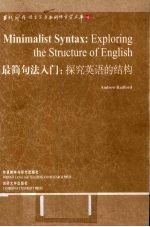

最简句法入门 探究英语的结构PDF电子书下载
- 电子书积分:16 积分如何计算积分?
- 作 者:Andrew Radford著
- 出 版 社:北京:外语教学与研究出版社
- 出版年份:2009
- ISBN:9787560081458
- 页数:512 页
1 Grammar 1
1.1 Overview 1
1.2 Traditional grammar 1
1.3 Universal Grammar 6
1.4 The Language Faculty 10
1.5 Principles of Universal Grammar 13
1.6 Parameters 16
1.7 Parameter-setting 21
1.8 Evidence used to set parameters 23
1.9 Summary 25
Workbook section 26
2 Words 33
2.1 Overview 33
2.2 Grammatical categories 33
2.3 Categorising words 38
2.4 Functional categories 40
2.5 Determiners and quantifiers 41
2.6 Pronouns 44
2.7 Auxiliaries 47
2.8 Infinitival to 49
2.9 Complementisers 52
2.10 Labelled bracketing 57
2.11 Grammatical features 58
2.12 Summary 60
Workbook section 62
3 Structure 66
3.1 Overview 66
3.2 Phrases 66
3.3 Clauses 71
3.4 Specifers 76
3.5 Intermediate and maximal projections 80
3.6 Testing structure 84
3.7 Syntactic relations 90
3.8 Bare phrase structure 94
3.9 Summary 96
Workbook section 98
4 Null constituents 106
4.1 Overview 106
4.2 Null subjects 106
4.3 Null auxiliaries 111
4.4 Null T in auxiliariless finite clauses 115
4.5 Null T in bare infinitive clauses 121
4.6 Null C in finite clauses 124
4.7 Null C in non-finite clauses 128
4.8 Defective clauses 131
4.9 Case properties of subjects 134
4.10 Null determiners 140
4.11 Summary 145
Workbook section 146
5 Head movement 151
5.1 Overview 151
5.2 T-to-C movement 151
5.3 Movement as copying and deletion 154
5.4 V-to-T movement 158
5.5 Head movement 162
5.6 Auxiliary raising 166
5.7 Another look at negation 170
5.8 Do-support 173
5.9 Head movement in nominals 178
5.10 Summary 181
Workbook section 183
6 Wh-movement 188
6.1 Overview 188
6.2 Wh-questions 188
6.3 Wh-movement as a copying operation 190
6.4 Wh-movement,EPP and the Attract Closest Principle 197
6.5 Explaining what moves where 202
6.6 Wh-subject questions 206
6.7 Pied-piping 211
6.8 Yes-no questions 220
6.9 Wh-exclamatives 222
6.10 Relative clauses 223
6.11 That-relatives 228
6.12 Summary 234
Workbook section 236
7 A-movement 241
7.1 Overview 241
7.2 Subjects in Belfast English 241
7.3 Quotatives and idioms 244
7.4 Argument structure 248
7.5 Thematic roles 250
7.6 Unaccusative predicates 254
7.7 Passive predicates 260
7.8 Long-distance passivisation 264
7.9 Raising 266
7.10 Comparing raising and control predicates 268
7.11 Summary 274
Workbook section 276
8 Agreement,case and movement 281
8.1 Overview 281
8.2 Agreement 281
8.3 Feature valuation 284
8.4 Uninterpretable features and feature-deletion 287
8.5 Expletive it subjects 291
8.6 Expletive there subjects 298
8.7 Agreement and A-movement 307
8.8 EPP in control infinitives 309
8.9 EPP in other infinitives 313
8.10 Summary 322
Workbook section 323
9 Split projections 327
9.1 Overview 327
9.2 Split CP:Force,Topic and Focus projections 327
9.3 Split CP:Finiteness projection 332
9.4 Split VPs:VP shells in ergative structures 336
9.5 VP shells in resultative,double-object and object-control structures 344
9.6 VP shells in transitive,unergative,unaccusative,raising and locative inversion structures 348
9.7 Transitive light verbs and accusative case assignment 356
9.8 Evidence for a further projection in transitive verb phrases 362
9.9 Extending the shell analysis to nominals 367
9.10 Summary 372
Workbook section 374
10 Phases 381
10.1 Overview 381
10.2 Phases 381
10.3 Intransitive and defective clauses 385
10.4 Wh-movement through spec-CP 388
10.5 Wh-movement through spec-vP in transitive clauses 391
10.6 Evidence for successive-cyclic wh-movement through spec-CP 394
10.7 Evidence for wh-movement through spec-vP in transitive clauses 401
10.8 The role of phases in lexical selection 407
10.9 Questions about phases 409
10.10 The nature of A-bar movement 419
10.11 Summary 426
Workbook section 427
Glossary and list of abbreviations 432
References 485
Index 498
- 《联吡啶基钌光敏染料的结构与性能的理论研究》李明霞 2019
- 《异质性条件下技术创新最优市场结构研究 以中国高技术产业为例》千慧雄 2019
- 《HTML5从入门到精通 第3版》(中国)明日科技 2019
- 《少儿电子琴入门教程 双色图解版》灌木文化 2019
- 《区块链DAPP开发入门、代码实现、场景应用》李万胜著 2019
- 《Python3从入门到实战》董洪伟 2019
- 《柏里曼人体结构绘画教学描摹本 第2册 头手足结构》杨建飞主编 2019
- 《小提琴入门新教程 第3册》王中男著 2018
- 《小提琴入门新教程 第2册》王中男编著 2017
- 《认知语言学视野的抽象方位结构研究》曹爽著 2019
- 《中风偏瘫 脑萎缩 痴呆 最新治疗原则与方法》孙作东著 2004
- 《水面舰艇编队作战运筹分析》谭安胜著 2009
- 《王蒙文集 新版 35 评点《红楼梦》 上》王蒙著 2020
- 《TED说话的力量 世界优秀演讲者的口才秘诀》(坦桑)阿卡什·P.卡里亚著 2019
- 《燕堂夜话》蒋忠和著 2019
- 《经久》静水边著 2019
- 《魔法销售台词》(美)埃尔默·惠勒著 2019
- 《微表情密码》(波)卡西亚·韦佐夫斯基,(波)帕特里克·韦佐夫斯基著 2019
- 《看书琐记与作文秘诀》鲁迅著 2019
- 《酒国》莫言著 2019
